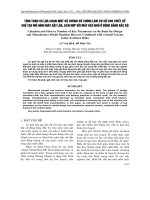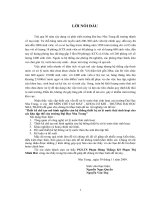Nghiên cứu, thiết kế chế tạo mô hình xe điện phụ vụ nghiên cứu về điều khiển chuyển động
Bạn đang xem bản rút gọn của tài liệu. Xem và tải ngay bản đầy đủ của tài liệu tại đây (8.98 MB, 39 trang )
CAPSTONE PROJECT
BUILDING ELECTRIC VEHICLE MODEL FOR MOTION
CONTROL PURPOSES
INSTRUCTOR: Msc Nguyễn Trung Hiếu
STUDENT: Trần Lê Thanh Minh
14145165
Lê Minh Phú
14145196
Faculty of Vehicle and Energy Engineering
Ho Chi Minh city University of Technology and Education
Outline
• Introduction
• System Theory Approach
• Design & Build The Electric Vehicle
• Simulation
• Experimental Result & Evaluation
• Conclusion & Recommendation
Trung-Hieu Nguyen
2
Introduction
• Motivations
• Project Overview
• Project Goals
Trung-Hieu Nguyen
3
Introduction
Motivations
• Reduce emission from ICE( internal combustion Engine)
• Use green and clean fuel sources
• Reduce mechanical components in vehicle
• Increase Efficiency
4
Introduction
Project Overview
History & Development of Electric Vehicle
• 1834, The first electric car was invented and commercialized
• 1899, The first electric car “La Jamais Contente” ran at speeds of over 100 km/h
• 2010, Development of California Tesla Motors
• 2017, Tesla Semi the first intelligent car.
5
Introduction
Project Overview
Introduction to Electronic Differential
6
Introduction
Project Overview
Tools for project
• Carsim 8.02
• Board STM32F4
• CATIA V5
• Matlab/Simulink
7
Introduction
Project goals
• Learn to use CATIA, MATLAB / SIMULINK, CARSIM and Board STM32F4
• Understanding technology that controls motion on electric vehicle
• Design vehicle using CATIA
• Simulating in-wheel BLDC motors and Electronic Differential System(EDS) with
Matlab / Simulink
• Validate control algorithm on Carsim with EDS
• Doing experiments based on STM32F4 and Matlab/Simulink
8
System Theory Approach
• Choosing Motor
• Building control algorihtm
Trung-Hieu Nguyen
9
System Theory Approach
Choosing Motor
Advantages motor
• Longevity
• Works almost no friction
• Wide speed range
• Can control wheel
In-wheel Motor With BLDC
10
Theory Research
Building Control Algorihtm
Control Scheme
• : Steering wheel angle (rad)
• : Angular velocity (rad/s)
• : The desired wheel angular velocity (rad/s)
• : Angular velocity on each wheel (rad/s)
• : Voltage supply to DRIVER (volt)
• EDS: Electronic Differential System
• PID: Speed controller
• DRIVER: The actuator supply voltage for motor
• SENSOR: Hall Sensor
11
Design & Build The Electric Vehicle
• Design The Electric Vehicle in CATIA
• Build the Electric Vehicle
Trung-Hieu Nguyen
12
Design & Build The Electric Vehicle
Design The Electric Vehicle in CATIA
Requirements
• Design standards:
Size & Price
Easy to Processing
Easy to Replace
Materials & durability
Stability & high accuracy
13
Design & Build The Electric Vehicle
Design The Electric Vehicle in CATIA Sofware
General Design
14
Design & Build The Electric Vehicle
Design The Electric Vehicle in CATIA Sofware
Frame Design
15
Design & Build The Electric Vehicle
Build The Electric Vehicle
Experimental Vehicle
16
Design & Build The Electric Vehicle
Build The Electric Vehicle
Wiring Diagram
17
Simulation
• Matlab/Simulink Programming
• Set-up CarSim Environment
Trung-Hieu Nguyen
18
Simulation
Malab/Simulink Programming
EDS Control in Simulink
19
Simulation
Set-up CarSim Enviroment
Size Parameter Settings
20
Simulation
Set-up CarSim Enviroment
Specifications Setting
21
Simulation
Set-up CarSim Enviroment
Control System Setting
22
Simulation
Set-up CarSim Enviroment
Communication Between CarSim & Simulink
23
Simulation
Set-up CarSim Enviroment
Dry Road Demonstration
24
Simulation
Set-up CarSim Enviroment
Dry Road (φ = 0.85)
25









